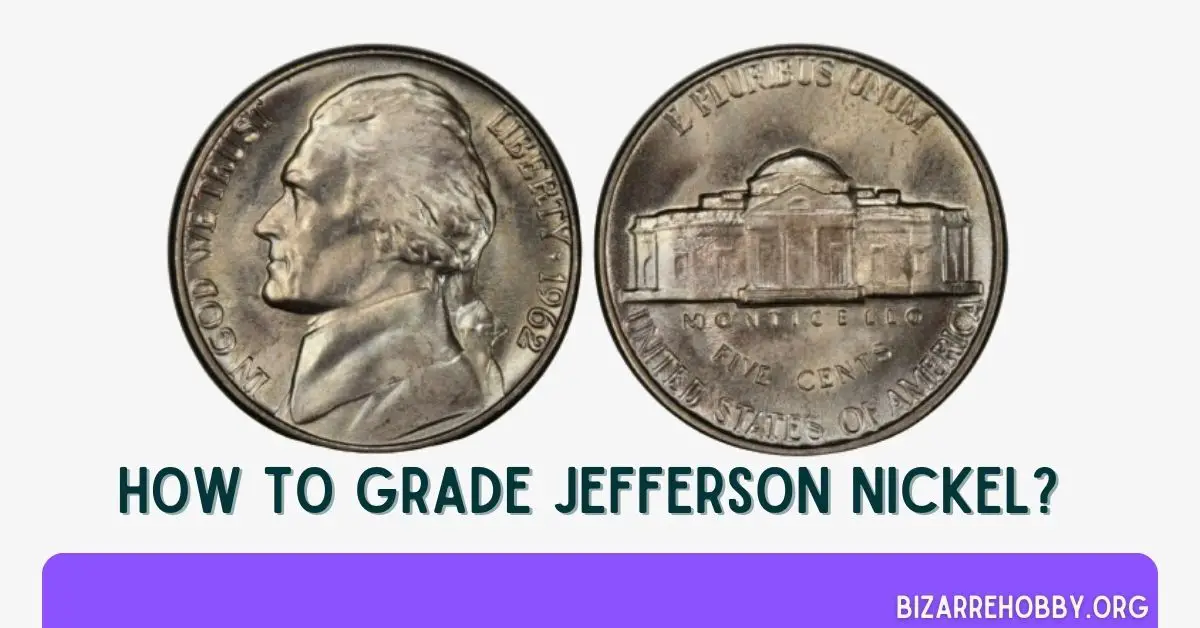While many Jefferson nickels are still in circulation, collectors often focus on the oldest and most pristine examples. However, grading each coin, especially those in high-grade mint state, is essential for determining their value.
You can grade Jefferson nickels yourself using established standards, which are generally sufficient for modern coins. However, serious numismatists often prefer professional grading for older coins to ensure accuracy.
Grading Standards for Jefferson Nickels
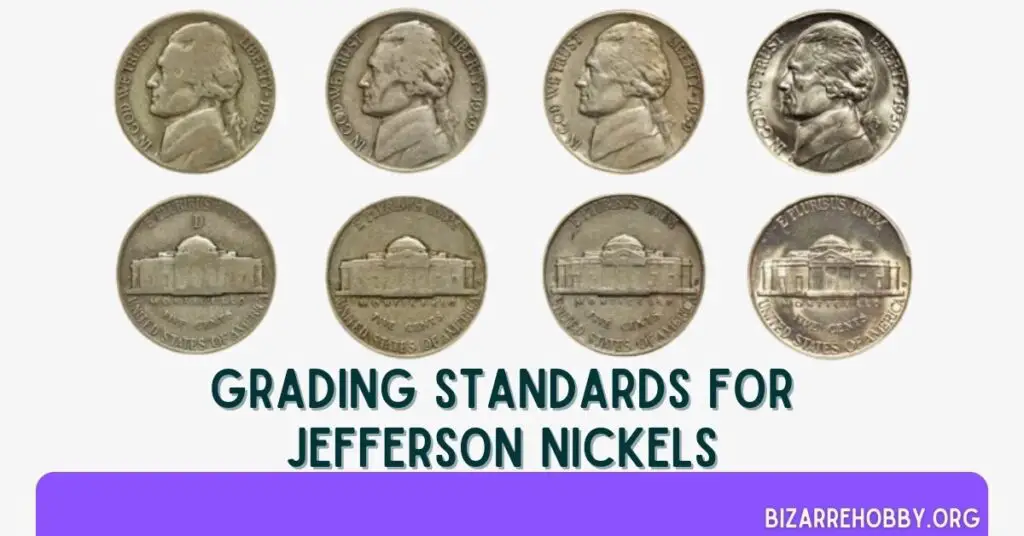
Grading a coin is crucial for assessing its market value. The process involves evaluating several factors, including:
- Initial strike quality
- Preservation level
- Wear and tear
- Possible damage
- Minting errors
Every detail matters, even those visible only under magnification. Subtle characteristics can significantly impact the value of rare coins with unique features.
Today, the modified Sheldon 70-point scale is widely used for grading. This scale is based on established and officially accepted definitions, making it a standard in the numismatic community.
| Sheldon Scale | Grade |
|---|---|
| 1 | Basal State-1 |
| 2 | Fair |
| 3 | Very Fair |
| 4, 5, 6 | Good |
| 7, 8, 10 | Very Good |
| 12, 15 | Fine |
| 20, 30 | Very Fine |
| 40 | Extremely Fine |
| 50 | About Uncirculated |
| 60 | Mint State |
| 65 | Mint State |
| 70 | Mint State |
Although grading is not an exact science, most numismatists and coin dealers adhere to these guidelines.
Jefferson Nickels Details
| Attribute | Detail |
|---|---|
| Face Value | Five cents ($0.05) |
| Compound | Cupronickel alloy |
| War nickels made of copper/silver/manganese alloy (from mid-1942 to 1945) | |
| Coin Weight | 0.176 ounces (5 g) |
| Coin Diameter | 0.835 inches (21.2 mm) |
| Coin Thickness | 0.077 inches (1.95 mm) |
Understanding Grades for Jefferson Nickels
Grading Jefferson nickels is unique due to the Full Steps variation found in many sets minted from 1938 to the present. Despite the long minting period, there are no significant rarities, thanks to the practice of saving uncirculated rolls.
Mints retain rolls of each new mint mark and date combination, preventing any specimen from becoming rare. However, collectors can still find rare varieties with over-date or over-mint marks and various error types.
Grading Jefferson nickels involves assessing each coin’s appearance and eye appeal, which depend on factors such as:
- Luster
- Number and location of contact marks
- Toning
- Strike sharpness, especially the steps in front of Monticello
The Full Steps quality varies by date and mint location. For example, 1940 D Jefferson nickels often have Full Steps, while those minted in Denver in 1960 rarely do. Completing a series with only nickels displaying 5 to 6 steps is nearly impossible.
How to Grade Jefferson Nickels?
Accurately grading Jefferson nickels is essential due to their growing popularity. Collectors seek both perfectly preserved and circulated coins. Each detail can affect a nickel’s value, so professional grading is recommended whenever possible.
1. About Good (AG)

- Obverse: Low-ranked nickels have an outlined profile of President Jefferson with minimal recognizable details. The date and inscriptions are readable but weak and often merge with the rim.
- Reverse: The Monticello building is visible as an outline, but individual details are unrecognizable. The coin rim is worn, and inscriptions are weak but legible.
2. Good (G)
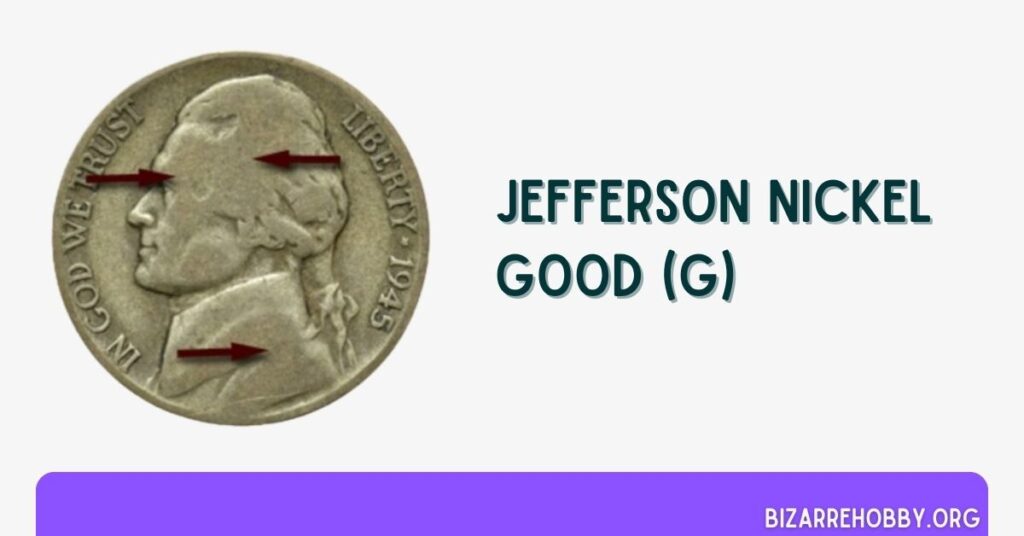
- Obverse: Thomas Jefferson’s profile is recognizable but lacks detail. Broad areas of flatness are present, and inscriptions and the date are weak and partially merged with the rim.
- Reverse: Monticello is outlined with minimal visible details. Pillars are barely recognizable, and the foundation line is almost flat. The mint mark and inscriptions are readable.
3. Very Good (VG, VG8, VG10)

- Obverse: The President’s cheek line is visible with smooth areas, and his hair is almost connected to the surface without distinct strands. The coat collar is weak but recognizable, and the lettering and date are readable.
- Reverse: The building shows slight details with worn pillars and a weak arch. Recognizing the second porch pillar from the right can be tricky.
4. Fine (F, F12, F15)
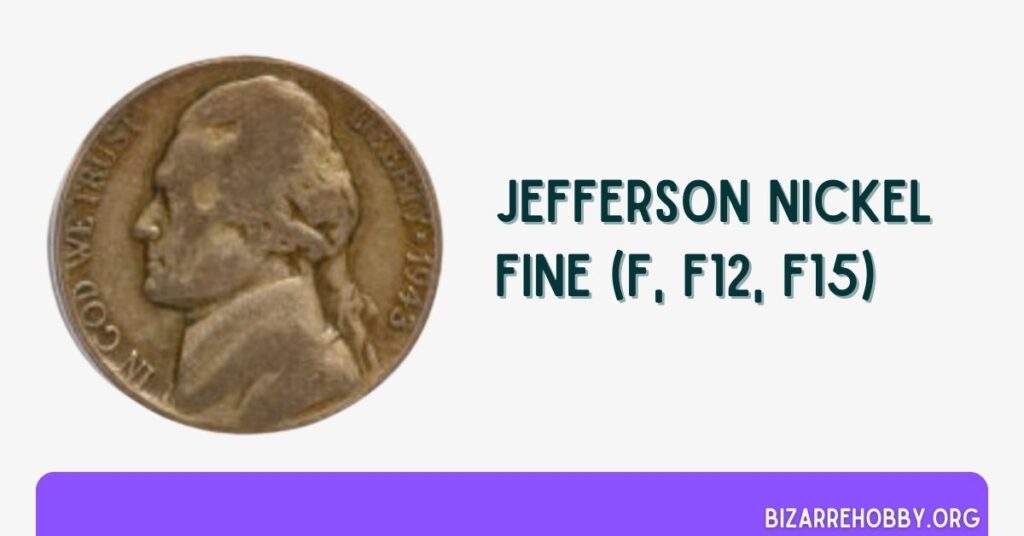
- Obverse: Details in the President’s hair frame his face, and the top areas of his head are smooth. The cheek line, cheekbone, and coat collar are weak and almost plain.
- Reverse: Pillars show some details, but the second one is faint, especially in the bottom third. The triangular roof is smooth, and the foundation line merges with vertical lines on the right side.
5. Very Fine (VF, VF20, VF25, VF30, VF35)
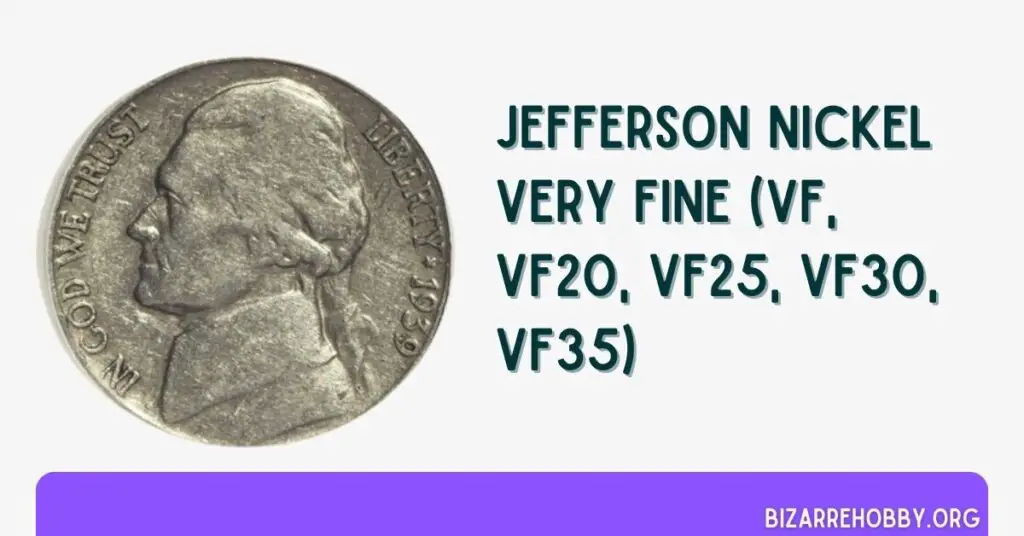
- Obverse: The President’s profile is recognizable with worn hair. Most strands are nearly separated, and the composition is detailed. The cheek is faded and flat, but contours are sharp.
- Reverse: The Monticello’s roof and triangular beam are flat but partially visible. Pillars have defined lines, and the second pillar is complete. All inscriptions are readable.
6. Extra Fine (EF40, EF45)
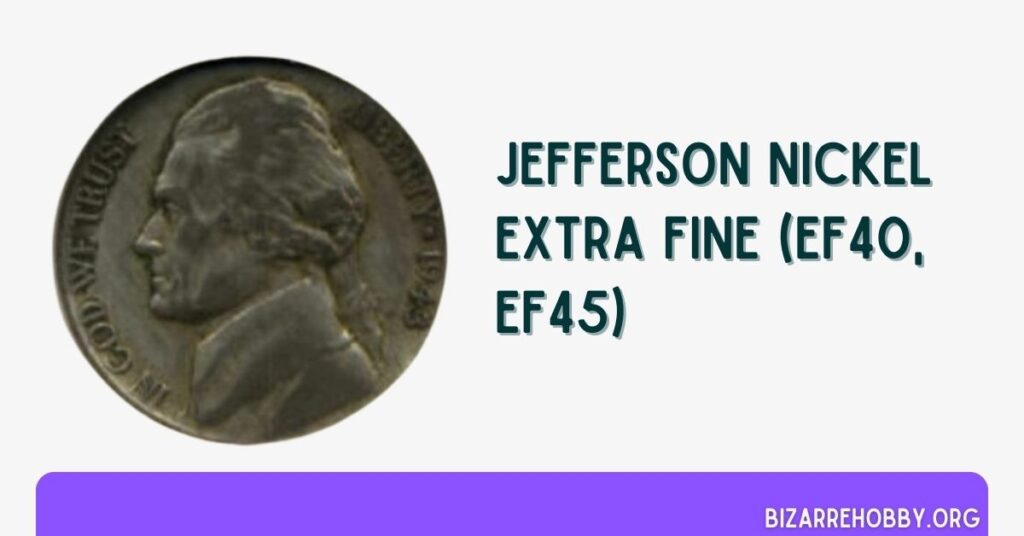
- Obverse: Slight signs of wear and lack of luster are visible on Jefferson’s cheekbone, hair, and bottom bust parts. The cheek is faded but separated from the area above the eye. The collar line is distinct at the shoulder.
- Reverse: Monticello is well-defined with bold-looking and recognizable pillars. The triangle has raised lines, although its appearance is still worn. Vertical house lines are visible, but the foundation line on the right partially merges with the walls. Traces of mint luster and readable inscriptions are present.
7. About Uncirculated (AU50, AU55, AU58)
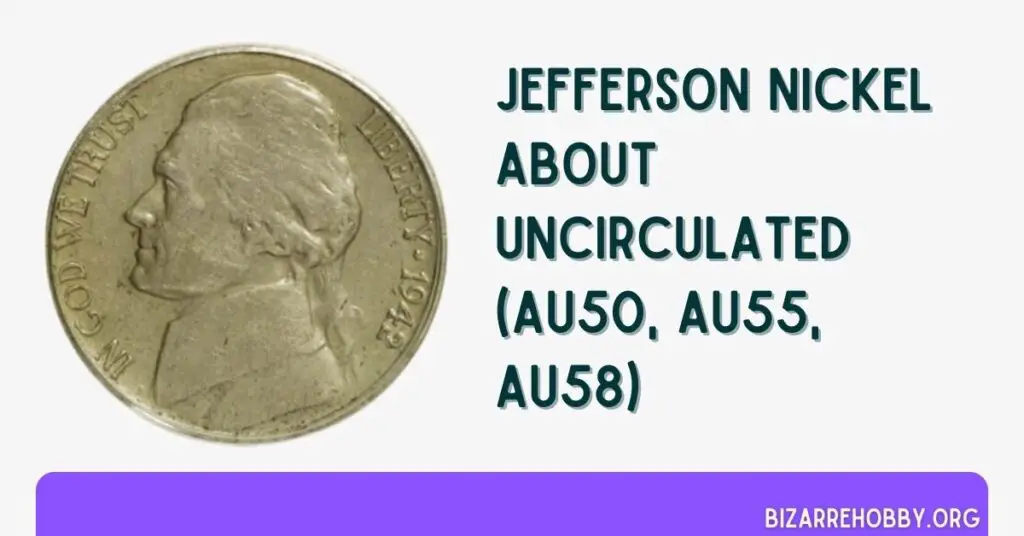
- Obverse: These nickels show slight wear on the President’s cheekbone and the highest points of his hair. The collar folds are discernible, with minor signs of use. Inscriptions and the date are readable, and most of the surface retains mint luster.
- Reverse: About 3/4 of the mint luster remains, with slight wear on the triangular roof and horizontal lines above well-defined pillars. Flattening is mostly on the high points of the design.
8. Mint State (from MS60 to MS70)
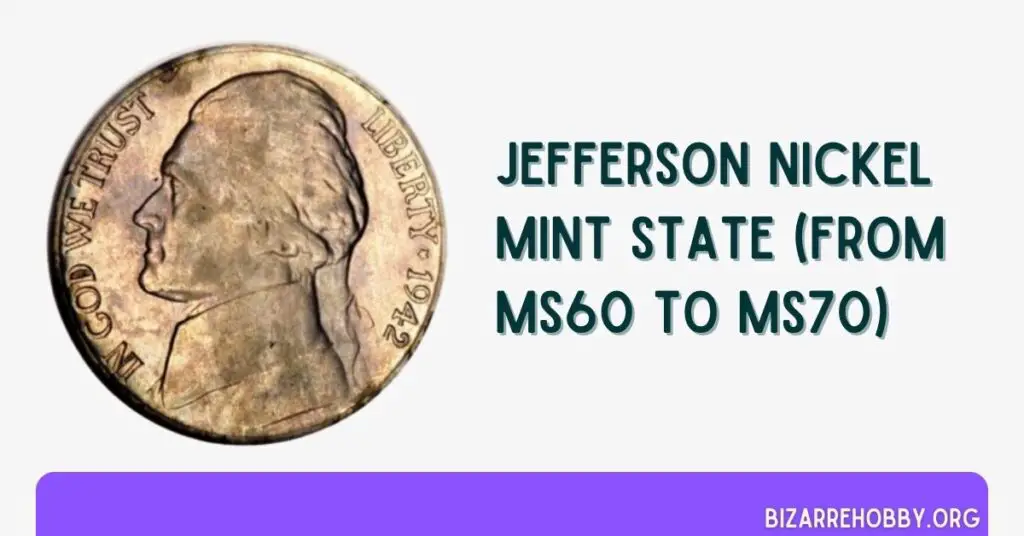
- Obverse: Mint State nickels exhibit delicate luster over the entire surface with no wear, including high points. The area above Jefferson’s eye is crucial, as it is prone to wear.
- Reverse: The pillars in front of Monticello’s entrance are the most sensitive part, wearing first during transactions. Complete pillars with full mint luster indicate a high-grade coin.
Full Steps
Jefferson nickels with the Full Steps feature match Felix O. Schlag’s original design, showing six steps in front of Monticello. Only rare specimens have all steps visible, with most coins showing four or fewer due to minting limitations. Grading companies recognize nickels with five or six visible steps as Full Steps, found only in mint state coins.
Final Thoughts
Grading Jefferson nickels is an essential skill for any coin collector, whether you’re a novice or an experienced numismatist. By understanding the grading standards and carefully examining each nickel’s details, you can accurately determine their value and rarity.
Remember, even the smallest characteristics can make a significant difference, especially for coins with unique features like the Full Steps. Always consider professional grading for older or high-value coins to ensure precision and authenticity. With this comprehensive guide, you’re well-equipped to grade Jefferson nickels confidently and enhance your collection.
